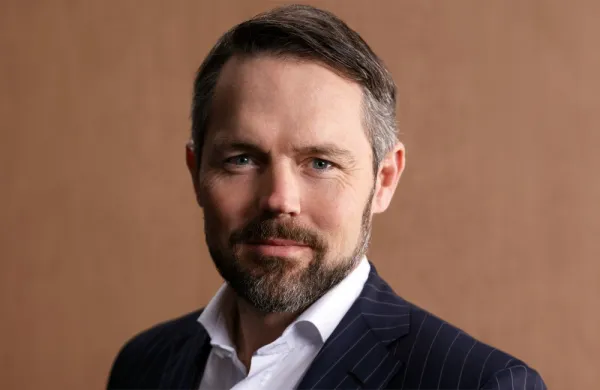Firing the chief investment officer was the final order of business at the Hawaii pension board’s regular meeting on February 12.
CIO Vijoy Chattergy was blindsided, insiders say. He likely had a lot on his mind.
U.S. stock markets had just crashed for the first time in years, and Chattergy was overseeing his state’s $17 billion pension fund. After seven years with the organization, Chattergy was told by his bosses that Monday that he was done, effective immediately. An official presented him with an agreement barring Chattergy from future work with any Hawaii state agency, according to two sources. He refused to sign.
“To put a ridiculous clause like that in his separation agreement — it was very vindictive,” says one investment industry veteran. “I’ve never seen anybody be dismissed like that, even people who’ve committed horrendous acts. When the news broke, people were just asking, ‘What happened? What did he do?’”
By the time Chattergy’s ouster was hot industry gossip coast to coast — that is, within days — it was no longer a mystery. “They got crushed on a low-vol bet,” my editor Kip McDaniel wrote me in a February 24 email. “Naked Put Selling Burns Hawaii Pension,” announced trade news website The Options Insider. Or, as one corporate pension investor put it, “Hawaii’s CIO . . . he went big into Bitcoin, right?”
The narrative took hold that Chattergy had blown up Hawaii’s pension fund with a risky bet turned bad, then lost his job over it. Passed on through a real-life game of telephone, this explanation cemented into accepted fact over the weeks following Chattergy’s departure. Everyone was talking about it; most everyone accepted the same basic premise. Indeed, in March I flew to Honolulu on assignment to verify the gossip and write “the inside story of Hawaii’s disastrous bet.” I was already in Oahu, fortunately for me, when I had to call my editor to say we had it all wrong.
Hawaii’s pension fund was selling puts, yes, but the strategy hadn’t come close to blowing up. It performed better than the overall market in February’s correction, according to fund documents. The Hawaii Employees’ Retirement System’s managers and management are uniformly offended by the notion that these bets led to the ouster of the CIO. But all anyone in the industry knew was that Chattergy was gone, and they assumed they knew why.
His downfall touched a nerve with institutional investors because Chattergy is one of their own. He’s well known on the conference circuit and friendly with the trade press, and he made time for those who made time to come to Honolulu, where no one just happens to be passing though. And in this community everyone knows the performance pecking order: who’s had a killer year, who’s middling, who’s vulnerable to being traded for a hotter player. Under Chattergy, Hawaii ERS had delivered, besting most of the public pension league in recent years. (He declined multiple requests for comment.)
Chattergy’s unceremonious dismissal, as a result, “was a surprise to pretty much everyone,” says a financier close to the fund.
In Tom Wolfe’s classic account of a different high-risk profession — military test pilot — the author describes how after every fatal crash, the surviving fighter jocks blamed their fallen peers even as they mourned them. “The bridge coats came out and they lifted a prayer about those in peril in the air and the bridge coats were put away and the little Indians were incredulous,” Wolfe wrote in The Right Stuff. “How could anybody fail to check his hose connections? And how could anybody be in such poor condition as to pass out that quickly from hypoxia?”
Chattergy’s investor comrades did much the same. How could anybody fail to cover his volatility shorts? And how could anybody be so reckless or ignorant as to implode on a 10 percent correction by writing puts?
“Two things hurt Hawaii,” an East Coast hedge fund manager speculated in late February. “One, trend-following strategies. They have a portfolio of these, and the Soc Gen [Société Générale] index is down 7 percent for the month. It probably hurt them. Number two, put-writing strategies, which is over $2 billion of the fund.”
Put writing, the manager explained, involves replicating exposure to stock markets via futures instead of an investor’s owning actual company shares. “You can hold a bunch of the money in cash, so it’s not necessarily riskier.” Still, betting on Apple with futures versus buying its stock requires less money down. “With the cash freed up,” he continued, “they’ve been selling volatility in the form of put options to other investors who are afraid of a crash. They’re selling insurance, like a car insurance company. The idea is that pension funds with long-term horizons, like Hawaii’s, can pay out in mini crashes and still make money in the long term. Selling insurance is a very profitable business — if you’ve priced it correctly.”
This hedge fund professional couldn’t say precisely how ERS’s program had cost Chattergy his job, but he had an educated hunch. Or rather, two hunches. “Was the insurance program appropriately sized? And did the board understand what that stuff was?” All of this armchair analysis entered an information vacuum, and filled it.
A Wall Street Journal article published two days before the ERS news broke, quoting Chattergy, set the incorrect investment disaster narrative in motion. “Harvard, Hawaii Gambled on Market Calm — Then Everything Changed,” the Valentine’s Day headline announced. The piece went on to say, “ ‘We’ve taken some losses that you’d expect with these sharp moves,’ said Vijoy Chattergy, the fund’s chief investment officer, on Feb. 8. He also said ‘they’re within expectations.’ ” Chattergy was correct, according to fund documents and remaining executives.
“As you know,” ERS executive director Thomas Williams said during a March 8 board meeting, “the article in The Wall Street Journal conflated our strategy with Harvard’s and Illinois’s. Of course, ours is entirely different, and actually had the opposite effect.” Investment director Anthony Goo expanded on where the narrative had gone wrong. “We’re cash covered, with no leverage being used. Beginning of February, investors or speculators were betting on the VIX [volatility index] continuing to go down. There has been a little misunderstanding from the pubic and especially by the media.” The correction, Goo said, “had little impact on the put-writing strategy — in fact, it performed in line with expectations, as we think it will continue to do so.”
Then there are ERS’s money managers, who designed, market, and run those purported VIX-shorting/trend-following/put-writing career grenades. “We have a lot of thoughts on that Wall Street Journal story,” says one manager who refused to be named. His tone suggests none of them are nice things. “These strategies are designed for not-calm markets. They’re designed for the exact opposite of what the title outlined!”
Gateway Investment Advisers manages the largest ERS mandate in question, about $1.7 billion across two sleeves of options-based equity strategies. Through a spokesperson, Gateway declined to comment. Another ERS manager, Neuberger Berman, sacrificed options chief Doug Kramer to the cause. Hawaii has about $600 million invested with Neuberger in the same subclass, stabilized growth, that Gateway helps manage. Kramer would not address Hawaii’s program specifically, but rather tried to explain collateralized put-writing strategies in general. “They’re liquid, they’re unlevered and generally pretty cost-effective.” As for the notion that Chattergy blew himself up, the unnamed manager called it “ridiculous. Totally ridiculous. He was very forward-thinking. They didn’t enter into this lightly. PCA put together a very thoughtful program.” PCA — the Pension Consulting Alliance — has long served as ERS’s main investment adviser. Neil Rue, PCA’s primary consultant, did not respond to a request to speak for the story.
ERS’s eight trustees voted to remove the chief investment officer on a Monday. The public, the pension beneficiaries, and much of the ERS staff learned of the decision in the Honolulu Star-Advertiser, which broke the story shortly after midnight that Thursday. “State Pension Trustees Fire Chief Investment Officer,” the headline from reporter Kevin Dayton revealed, citing sources familiar with the action. Some unnamed trustees pointed to problems with Chattergy’s “management style” as the motivating factor, according to Dayton. ERS’s Williams refused to discuss the situation, citing policy. The organization and Chattergy remained tight-lipped as other publications (including this one) picked up Dayton’s scoop and requested comment.
After the Star-Advertiser story came out, Williams formally told ERS staff via email, a copy of which was obtained by Institutional Investor.
If the fictional downfall of Chattergy hit home for U.S. investors, the truth of his demise will cut to the core — for what happened to him could happen to most any institutional CIO.
Raised in Oahu, Chattergy, like most of the island’s upper-class youth, moved to the mainland for college and the early part of his career. Next came College of the Holy Cross, Teach for America, the London School of Economics, the Federal Reserve, Cornell University, and nearly five years at an asset management firm in Tokyo and Hong Kong. He returned to his island home in 2009, and in 2011 joined ERS, which had been essentially a one-man investment band running $10 billion, with heavy board involvement. In 2008, CIO Rodney June had left Los Angeles’s retirement system to lead Hawaii’s. After four years he jumped at L.A.’s offer to come back as CIO. Chattergy got the top job in the interim, and then, in November 2012, permanently.
Turnover giveth, and turnover taketh away. Chattergy’s troubles began when the CIO’s bosses’ tenures ended.
In a rare hire of a mainlander, ERS in 2015 named Thomas Williams executive director, luring the former TIAA executive out of retirement and Rocky Mountain winters. After leading Wyoming’s public pension fund, Williams said, “I had elected to retire, and got a little bit bored. I was cleaning out old issues of P&I [Pensions & Investments], feeling guilty that I hadn’t read them, and saw the job ad. Expressions of interest were due in, like, two days.” He set to work.
Two and a half years in, Williams seems fully assimilated to island life. He — like every man at ERS’s board meeting, including consultants — wears the Honolulu businessman’s uniform of Hawaiian shirt, slacks, and loafers with dark socks. Williams has also picked up on the state’s unique politics better than many natives, insiders say. “My focus has been with the legislature,” Williams says of his tenure thus far, during an interview with Institutional Investor in Honolulu — the first given to national press since Chattergy’s dismissal. “The organization is almost fully controlled by them.” Before ERS can replace an employee, for example, lawmakers have to approve its choice of candidate. At Williams’s urging they’ve signed off on much bigger, costlier ERS demands — financially and politically speaking. “We’re lowering our assumed rate of return to 7 percent from 7.5 percent, and adjusted for having the longest life expectancies in the country.” In turn, government employers have agreed to ramp up contributions.
As Williams managed up and scored wins, he and Chattergy began butting heads, according to four sources with knowledge of their relationship. The balance of power between the two men further shifted with the departure of two board members partial to Chattergy. “I did see tension developing over time, but it didn’t rise to this level” until the board transitioned, says one insider. “I think they were looking for somebody to be more at home and less in the investment world. Vijoy thought it was really important to have visibility as a player in the broader world.” A childhood friend of Chattergy’s echoes this assessment. “When you go into a setting where people don’t like change and you push to do better, people perceive you as self-promoting — particularly coming from the finance industry. He stuck out too much, and perhaps that didn’t sit well with people in the organization. I think he had high expectations of the people who work with him, and that may not have been the job they signed up for.” Three financial sector veterans reported to Chattergy as investment officers, supported by a few junior staffers.
If any single thing ushered in Chattergy’s demise, it was travel. Chattergy frequently attended industry conferences and awards events, and was nearly always on the agenda, according to public documents. He saw meeting asset managers and his peers as a critical function of a chief investment officer. His board members disagreed. Chattergy, however, did not change his views or actions, three sources say, and instead began to pay out of pocket occasionally for professional travel when it was rejected by the board.
“The travel had to all go through the state requisition process, so it was very visible politically,” says a professional with intimate knowledge of ERS procedures. “And it was a lot. Most of the people traveling for the state submit a travel plan months in advance, and they travel once or twice a year. That’s just not how our industry works. They’d submit a plan, and then prices would change and they’d have to amend it. It was a nightmare — a real nightmare.” Watching the process, the source was left wondering, “Why are they doing this?”
Williams wouldn’t acknowledge on the record that travel had explicitly factored into Chattergy’s dismissal — or that the CIO was fired at all. But Williams did emphasize that for the next investment chief, “there is plenty of work to be done right here at home” — as opposed to elsewhere.

Acting CIO Howard Hodel, an investment risk specialist, says he’ll probably apply for the permanent post. Asked if the role will change, Williams says he envisions sharing portfolio oversight among an internal investment committee, not concentrating it with the CIO. Hodel jumps in to agree: “I personally don’t like the star system. It should be more of a level playing field” on an investment team.
“I like the star system,” Williams counters. “As long as everybody’s a star.”
In the end, Chattergy was either not enough of a star or too much of one for the trustees and the executive director to tolerate. Williams treads cautiously on the topic, but eschews prepared statements. “I think our CIO made significant contributions to our progress, and he is highly regarded nationally and locally. We have spent the last nine to 12 months on our way to realizing the vision” he helped set. “I think it’s inevitable that as professionals grow, they sometimes outgrow their positions,” Williams continues. “The organization and Vijoy had to decide what was in everyone’s best interests. And Vijoy decided resigning to pursue other opportunities was in his.” (Chattergy did not resign, according to both Williams’s own email to staff and two sources with direct knowledge of the situation. Chattergy was fired, but he and the organization agreed subsequently to say that he resigned.)
Williams said what an organization’s leader should after executive upheaval, according to crisis PR consultant Davia Temin. He just did it a month too late. “People are let go all the time,” says Temin, who reviewed the timeline and the documents associated with Chattergy’s ouster. “Whether the reasons are pretty benign or more egregious, the best practice is to act with the most elegance possible. And that means you allow someone their dignity as they leave,” she notes. “You don’t malign them or allow them to be maligned by doing and saying nothing, by keeping it a mystery. People will fill in that huge void with something far worse than reality — it’s human nature.”
Several people close to Chattergy worry that that imagined “something” could be worse even than naked put selling. At this particular cultural moment, a man is abruptly fired from a position of power for no obvious reason? “Everybody thinks it’s got to be sexual harassment,” says a longtime professional contact of Chattergy’s. “You never expect that, of course. But it did not sound right at all.”
I ask Williams to address this directly and for the record. Regarding Chattergy, “there are no underlying concerns about fiscal or financial conduct, sexual harassment, or fraudulent or criminal behavior,” Williams says emphatically. “Anything that suggests otherwise is off the mark.”
Exchanges like this are the kind of thing Temin & Co. would try to head off. “I would have suggested doing this differently,” says Temin, the firm’s president. “Not being party to the situation, one would still like to exit someone with a degree of dignity.” As it is, “it puts everyone else at the institution on notice that this too could happen to them, and it would be handled the same way.”
The botched breakup of Hawaii ERS and its CIO besmirched reputations beyond Chattergy’s. Williams asserted “absolutely no correlation” between the firing and ERS’s trend-following and put-writing strategies’ performance. “They probably have more to do with Rex Tillerson’s firing. It doesn’t speak highly of how people think we’re managed that they’d assume that. When reaching for explanations,” Williams acknowledges, “you grasp at things that may not be related.”
Even Chattergy’s allies take offense on his behalf. If their friend had to be unceremoniously booted from his dream job, let it be known it wasn’t over his investing. “I think the strategies they were exploring and implementing, and the way they were going about the strategic moves, were deliberate and thoughtful, due in no small part to Vijoy and his openness to bring the board along,” says one industry expert. “There’s a lot of misinformation; the reality doesn’t square with everyone’s worst fears that these exotic things blew them up. The decision had been baked to fire Vijoy well before those reports came in.”





